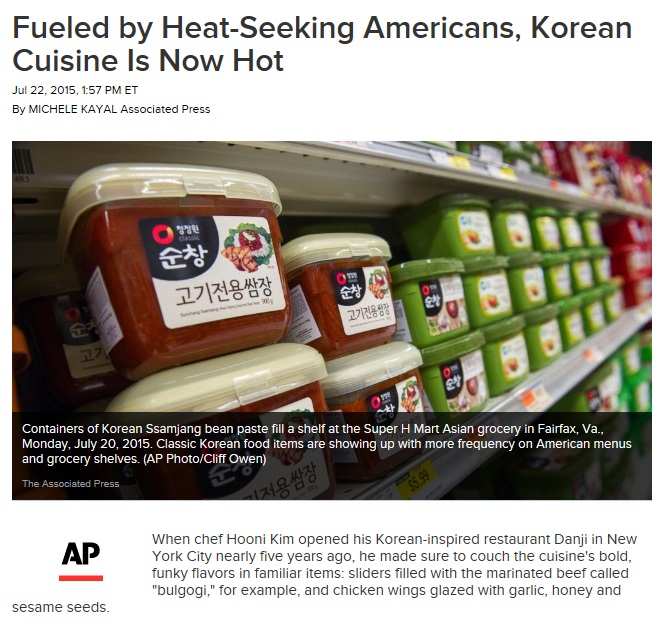-
 Korea.net's 24-hour YouTube channel
Korea.net's 24-hour YouTube channel- NEWS FOCUS
- ABOUT KOREA
- EVENTS
- RESOURCES
- GOVERNMENT
- ABOUT US
All eyes are on Korean cuisine and the base process of fermentation that requires a long cooking period and which produces rich, subtle flavors. On July 22 and 23, the Associated Press (AP) published two articles about Korean fermented foods and the way in which chefs turn their ingredients into dishes. The article introduces readers to a number of dishes made using fermented condiments as its keys to enticing diners with traditional ingredients.
The July 22 article, titled "Korean foods making inroads in America via pantry staples," was contributed by U.S. chef Edward Lee. The article started out saying that, "Everywhere you look, Korean food is screaming off the trend charts." Lee mentioned that kimchi, Korean barbeque and fermented red pepper paste, gochujang, are, "universally loved," and that it is, "[having] its heyday," these days.
Lee said that, "the rise of Korean food in America is driven by its pantry ingredients." He said that the versatility of ingredients and the way in which they are "morphed" are two reasons for their success, adding that, "the ingredients are [adaptable] to everything from burgers to poutine." The star chef explained that there is now no longer a clear boundary between Western influences and traditional flavors, and that it makes audiences, "hungry for more umami and spice."
He also showed an interest in a fermented red pepper paste. "Chefs have been using it for years to add depth to stews, glazes and marinades," he said, continuing to talk about its slightly more complex version, ssamjang. "The seasoned dipping sauce mixed with pepper paste, garlic, sesame oil and soybean paste has so much more potential than being only a condiment," he says, adding that, "without the limiting blinders of tradition, American chefs will see it as a limitless pantry item."

The July 23 article continued to report on the traction that Korean cuisine is gaining in North America. In the article "Fueled by heat-seeking Americans, Korean cuisine is hot, hot, hot," reporter Michele Kayal explained that there were efforts in the past to, "couch the cuisine's bold and funky flavors," but that now there is no such need because, "a growing fascination with fermentation, the perennial quest for spice, and expert adaptation by trained chefs has nudged Korean food closer to the American mainstream."
These days, indeed, more and more chain restaurants are offering new menu items, such as Korean barbecue and Korean tacos, "a mash-up of Asian flavors in Mexican format," said Kayal. In those restaurants, she explained, mentions of "Korean" on menus have blipped up two percent over the past year, while mentions of "kimchi" are up 7.5 percent, making Korean the, "new 'it' cuisine."
Finally, she quoted Matt Rodbard, co-author of an upcoming book, "Koreatown: A Cookbook," for some more details about the love Americans have for the spiciness of Korean cuisine. The author was quoted as saying that Korean barbeque and Korean tacos are, "the gateway drugs [for] Korean food," adding that, "Korean is the next one of these East Asian and South Asian cuisines to take hold."
By Lee Seung-ah
Korea.net Staff Writer
slee27@korea.kr
The July 22 article, titled "Korean foods making inroads in America via pantry staples," was contributed by U.S. chef Edward Lee. The article started out saying that, "Everywhere you look, Korean food is screaming off the trend charts." Lee mentioned that kimchi, Korean barbeque and fermented red pepper paste, gochujang, are, "universally loved," and that it is, "[having] its heyday," these days.
Lee said that, "the rise of Korean food in America is driven by its pantry ingredients." He said that the versatility of ingredients and the way in which they are "morphed" are two reasons for their success, adding that, "the ingredients are [adaptable] to everything from burgers to poutine." The star chef explained that there is now no longer a clear boundary between Western influences and traditional flavors, and that it makes audiences, "hungry for more umami and spice."
He also showed an interest in a fermented red pepper paste. "Chefs have been using it for years to add depth to stews, glazes and marinades," he said, continuing to talk about its slightly more complex version, ssamjang. "The seasoned dipping sauce mixed with pepper paste, garlic, sesame oil and soybean paste has so much more potential than being only a condiment," he says, adding that, "without the limiting blinders of tradition, American chefs will see it as a limitless pantry item."

A recent Associated Press article writes about red pepper paste, one of Korea's many fermented condiments, and the U.S.' love for the seasoning.
The July 23 article continued to report on the traction that Korean cuisine is gaining in North America. In the article "Fueled by heat-seeking Americans, Korean cuisine is hot, hot, hot," reporter Michele Kayal explained that there were efforts in the past to, "couch the cuisine's bold and funky flavors," but that now there is no such need because, "a growing fascination with fermentation, the perennial quest for spice, and expert adaptation by trained chefs has nudged Korean food closer to the American mainstream."
These days, indeed, more and more chain restaurants are offering new menu items, such as Korean barbecue and Korean tacos, "a mash-up of Asian flavors in Mexican format," said Kayal. In those restaurants, she explained, mentions of "Korean" on menus have blipped up two percent over the past year, while mentions of "kimchi" are up 7.5 percent, making Korean the, "new 'it' cuisine."
Finally, she quoted Matt Rodbard, co-author of an upcoming book, "Koreatown: A Cookbook," for some more details about the love Americans have for the spiciness of Korean cuisine. The author was quoted as saying that Korean barbeque and Korean tacos are, "the gateway drugs [for] Korean food," adding that, "Korean is the next one of these East Asian and South Asian cuisines to take hold."
By Lee Seung-ah
Korea.net Staff Writer
slee27@korea.kr













